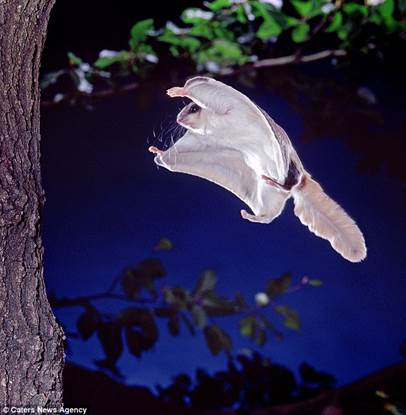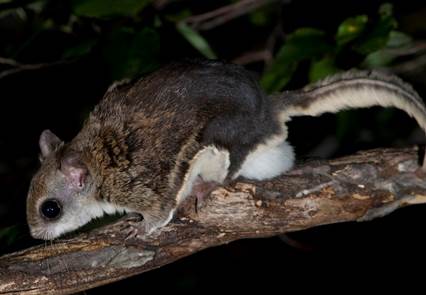is furry Quaker jacket
Is trimmed with stripe of black;
A furry plume to match it
Is curling o’er his back;
New curved with every motion,
His plume curls o’er his back.
– from The Flying Squirrel, Mary E. Burt
The southern, or sometimes referred to as eastern flying squirrel, is found in extreme south eastern Ontario and southern Quebec, and south through most of the eastern U.S. Small, disjunct populations occur in Mexico and Central America. They are found in deciduous and mixed forests and will occupy conifer forests particularly when beech and oaks are close.
Glaucomys – Greek glaukos (gray) and mys (mouse) — volans – Latin for “to fly”. It was first described in 1758 from a specimen in Virginia.
Flying squirrels have small rounded heads, large black eyes, prominent ears, long whiskers and furry tails. They have dense fur that has a soft and silky feel. The tail is dorso-ventrally (horizontally) flattened with its long hair forming parallel sides and a rounded tip. The upper portions of the body, head, and tail are an olive gray. The underparts of the body and head are white to creamy white – the underside of the tail is grayish to white. The southern flying squirrel is 8 – 10 in long and weighs 1.6 – 2.5 oz. There is a northern flying squirrel – a separate species that extends through Canada and the northern U.S. including WA.
Southern flying squirrels feed on beechnuts, acorns, hickory nuts, and other large seeds that they store in their nests, the ground, or in crevices in tree trunks. Because they do not hibernate they rely on their stash of the autumn nut harvest and also are known to forage at bird feeders. They also feed on fruits, fungi and some species of lichens. They are known to eat more animal foods than other squirrels including carrion, bird eggs, mice, shrews, invertebrates and nestling birds. Because they are nocturnal they are not observed very often but, for some reason, they are attracted to blue light so placing one to shine on your bird feeder could increase your chance of seeing one. One of my brothers back in N.J. recently sent me a photo of a flying squirrel visiting his bird feeder.
Not so much is known about their reproductive behavior, but they have litters in April and May and then again in August and September. It’s not clear if this is the same females having two litters or a bimodal distribution of the breeding population – some females breeding early and others later in the season. Gestation is about 40 days and the young weigh about 0.1 -0.2 oz at birth. Their eyes open at 28 days and they are weaned at 35-42 days. The young may stay with their mother until she breeds again. Some young will breed as yearlings with the remainder becoming sexually mature at 2 years of age. They have lived up to 10 years in captivity but few adults in the wild survive beyond 5 years. Known predators include raccoons, foxes, weasels, bobcats, hawks, owls, and house cats.
Studies indicate a variable social system with an aggressive defense of territory. Where nest cavities are abundant with a uniform distribution of food trees, breeding females maintain territories that include most of their home range. Home ranges vary in size but average about an acre for females and 1.5 acres for males. The female will temporarily associate with a male but both occupy separate nests and males do not aid in the rearing of the young. But during the winter up to 19 individuals have been recorded communally nesting – likely to conserve body heat.Flying squirrels are the most nocturnal and arboreal of the tree squirrel. While they do forage on the ground the vast majority of their time is spent in the trees. And of course, they have the ability to glide from one tree to another, a unique skill among the rodents. Imagine if rats could do this! On second thought, don’t.

Before leaping off a perch flying squirrels will bob their head from one side to another, rotating their head to gauge their landing spot. They jump and then spread their legs to stretch the membranes that extend between their back and front legs, which allow them to glide to their target. Before landing they pull up their head and tail, and fleshy pads on the feet help to cushion the impact. A short video by the great David Attenborough http://www.wimp.com/flyingsquirrels/
I’ve been lucky enough to have seen this squirrel a few times. The first was when I was in graduate school in western MD while we were out in an older oak-hickory forest, taking a number of habitat measurements for a field class. Several of us were working together when I came upon a white oak snag, broken off about 30 ft up, with a cavity about 10 ft up. I had a Biltmore stick (to rapidly measure dbh) and tapped the snag with it and out popped a flying squirrel. We watched him jump over to another tree and then sit on a branch about 80 ft up. Then someone else noticed another one and pointed it out, a bit higher on a nearby tree. Just as I turned to look the squirrel on the higher branch launched off. We watched and collectively let out an ooohh! as it silently glided through the open column of trees for 100 ft and then stuck to the side of a large mockernut hickory like Velcro. The second one then launched off and glided to another perfect landing and we all felt very lucky.
Not so much for Sal and Mike, two younger graduate students who later that autumn were working on a small mammal study and caught a flying squirrel in one of their traps. The easiest and safest way to get a small mammal out of one of these small, metal Sherman live-traps is to take a light canvas bag, place it over the hinged back door, open it inside the bag while keeping the bag sides pinned to the trap, and then shake the critter into the bag. You can then corner him in the bag and from the outside of the bag, grab him by the scruff of the neck, turn the bag inside out, and then take the necessary measurements before releasing him.
Sal and Mike were not studying flying squirrels but thought what-the-heck, we might as well put a ring tag on his leg since we captured him. They were getting quite cocky having handled a number of small mammals over the past year and made two mistakes – 1) not putting on a leather glove, and 2) not using the above technique for handling. Instead, Sal decided he was nimble enough to just grab the squirrel by the scruff directly. Small mammal minutia – some small mammals – most voles, mice, woodrats, and shrews — can be safely handled this way because they don’t have a lot of loose skin and thus, can’t just turn around and bite you. Not so with others such as chipmunks – which are quite aggressive (really!) and have loose skin on their neck so you can get quite surprised. The same goes for flying squirrels.
Shortly after pulling the squirrel out of the bag it simply turned its head and with a pretty vicious chomp latched on to the heel of Sal’s hand, that meaty portion below the thumb. Sal acted as if a car door had just slammed on his thumb, was leaping about and vigorously trying to shake off the little demon attached to him. After about 30 seconds of dancing around and shaking he finally flung it to the ground. The squirrel, shocked and disoriented, paused for a second and then made a bee line to Mike, ran up his pant leg and lodged himself on his thigh, about 5 inches from his crotch.
Mike froze and with wide eyes asked Sal – “What do I do?” There seemed not much of a choice and not wanting to antagonize the rodent further, he slowly undid his belt and zipper, and lowered his pants. Both parties were relieved as the squirrel sprung free. Sal and Mike called it a day, went home to wash out Sal’s wound, and soothe themselves with a couple of well-earned beers.
Holy smokes Bullwinkle! – Rocky
